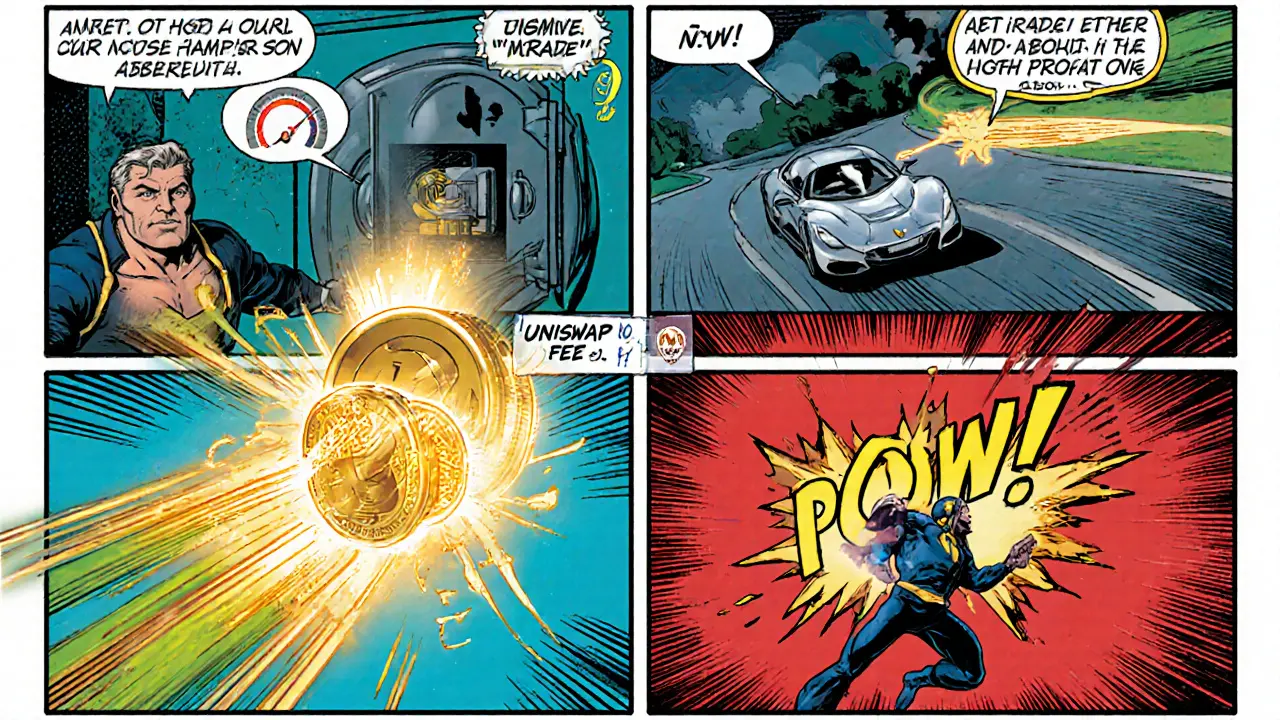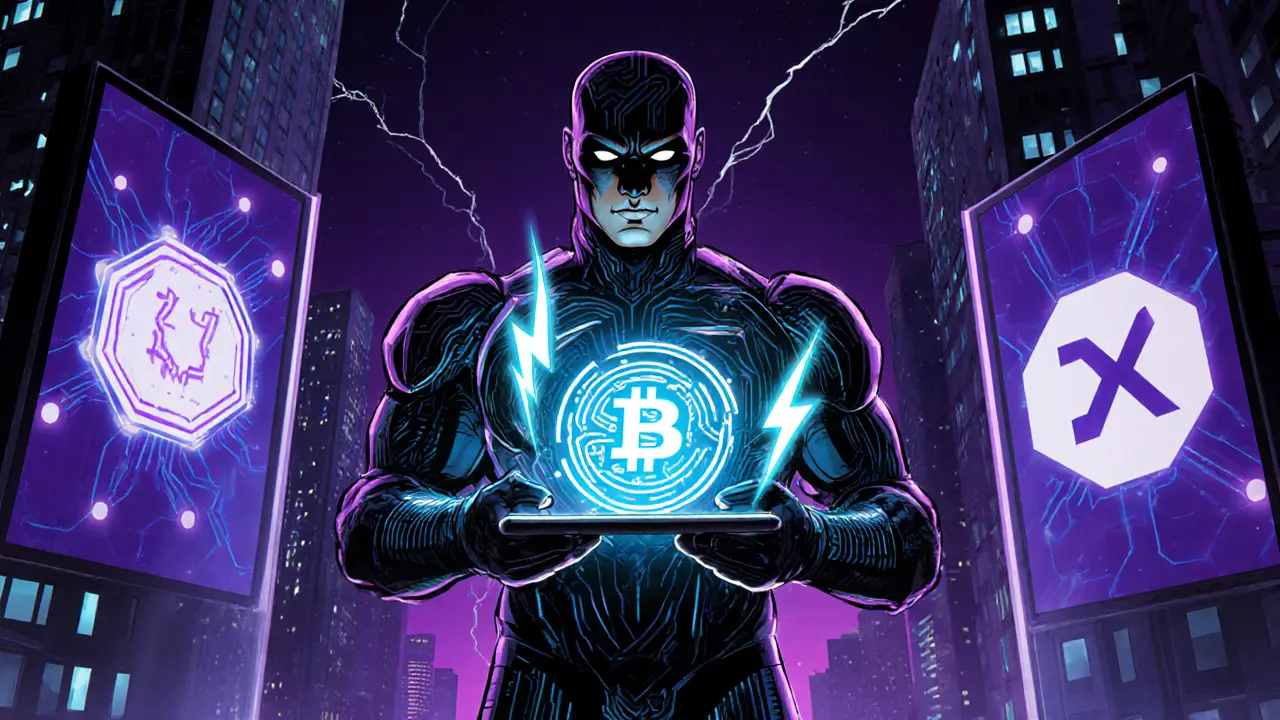Flash Loan Arbitrage Calculator
Profitability Analysis
Cost Breakdown
| Cost Component | Value | Impact |
|---|---|---|
| Flash-loan fee | 0.90 USDC | Negligible |
| Gas cost | 5.00 USDC | Significant on congested blocks |
| Slippage tolerance | 3.00 USDC | Reduces gross spread |
| MEV competition | 2.00 USDC | Can be avoided with private relays |
Ever wondered how traders move millions of dollars in a single blockchain transaction without posting any collateral? The secret sauce is flash loan arbitrage - a high‑speed, risk‑controlled play that lets you borrow, trade, and repay-all inside one block. Below you’ll find a step‑by‑step guide, real‑world profit examples, and the exact tools you need to start hunting price gaps across decentralized exchanges.
Key Takeaways
- Flash loans let you borrow up to the entire liquidity of a pool without collateral, as long as you repay within the same transaction.
- A profitable arbitrage loop must cover the flash‑loan fee (usually 0.09% on Aave), gas costs, and slippage.
- Real‑time price monitoring across at least three DEXs (e.g., Uniswap, SushiSwap, Curve) is essential to spot fleeting spreads.
- Smart‑contract security, gas‑price optimization, and MEV‑friendly routing dramatically affect success rates.
- Regulatory risk remains low now, but future DeFi rules could change loan availability.
What Exactly Is Flash Loan Arbitrage?
Flash Loan Arbitrage is a DeFi strategy that uses an uncollateralized loan, executes a series of trades that exploit price differences between markets, and repays the loan-all within a single atomic transaction. Because the blockchain either commits the whole sequence or reverts it, the trader never faces traditional loan default risk.
How Flash Loans Work on Major Protocols
Two of the most widely used providers are Aave and Balancer. Aave’s V3 implementation charges a flat 0.09% fee on the borrowed amount, while Balancer uses a variable fee based on pool utilization. Both expose a single entry point (flashLoan or vault.flashLoan) that calls back a user‑defined receiveFlashLoan function where the arbitrage logic lives.
Typical Profit Flow - A Concrete Example
- Borrow 1,000USDC from Aave (fee = 0.9USDC).
- Swap USDC → ETH on Uniswap at 2,500USDC per ETH, receiving 0.4ETH.
- Immediately sell 0.4ETH on SushiSwap at 2,550USDC per ETH, gaining 1,020USDC.
- Repay 1,000.9USDC to Aave (principal + fee).
- Keep the net profit: 1,020-1,000.9=19.1USDC, minus gas (≈5USDC on a congested block) = ~14USDC net.
This simple loop shows why a price spread of just 2% can be lucrative once you factor out the negligible loan fee.
Detecting Real‑Time Opportunities
Price gaps close in milliseconds, so manual scanning is impossible. Successful bots use a combination of:
- On‑chain subgraph queries (TheGraph) to pull last‑block prices from each DEX.
- Off‑chain price oracles (Chainlink) for reference rates.
- Custom aggregators (0x API, 1inch) that batch multiple quotes into a single response.
The algorithm calculates the gross spread, subtracts estimated gas (based on current Gas Fee market rates), and applies a safety margin (e.g., 0.3% slippage tolerance). Only when the projected net profit exceeds a pre‑set threshold (often 0.5% of the loan size) does the bot fire the flash‑loan transaction.

Building the Arbitrage Smart Contract
A minimal contract must implement the following interface (simplified for illustration):
interface IFlashLoanReceiver {
function executeOperation(
address[] calldata assets,
uint256[] calldata amounts,
uint256[] calldata premiums,
address initiator,
bytes calldata params
) external returns (bool);
}
Key steps inside executeOperation:
- Decode
paramsto get target DEX router addresses. - Call
swapExactTokensForTokenson the first DEX. - Immediately call the second DEX with the received token.
- Calculate the repayment amount (principal + premium) and approve the lending pool.
- Transfer any leftover balance to the profit‑collector address.
Optimizations that shave gas include:
- Using
callinstead oftransferto avoid extra SLOADs. - Batching token approvals into a single
permit(EIP‑2612) transaction. - Deploying separate contracts for each token pair to reduce conditional logic.
Cost Analysis: Fees, Gas, and MEV
Even a perfect spread can be wiped out by hidden costs. Break down the typical expense profile:
| Cost Component | Typical Value | Impact on Profit |
|---|---|---|
| Flash‑loan fee (Aave) | 0.09% (0.9USDC) | Negligible |
| Gas (Ethereum Mainnet, % gas price 30gwei) | ≈200,000gas ≈5USDC | Significant on congested blocks |
| Slippage tolerance | 0.3% (≈3USDC) | Reduces gross spread |
| MEV competition (Flashbots premium) | 0.2% (≈2USDC) | Can be avoided with private relays |
When the net spread after these deductions stays above zero, the arbitrage is viable. Note that gas costs fluctuate with network demand; during spikes, the same trade can turn unprofitable.
Risk Management Strategies
Even though the loan is atomic, you still face three main risk buckets:
- Technical risk: Bugs in the contract could cause a revert after the loan is taken, leading to a failed transaction and lost gas.
- Economic risk: Sudden price movement while the transaction is pending can erode the spread.
- Regulatory risk: Future DeFi legislation could limit flash‑loan availability or impose reporting requirements.
Mitigation tactics include:
- Run the contract through static analysis tools (Slither, MythX) before deployment.
- Set a dynamic profit threshold that scales with gas price (e.g., require at least 1% net profit when gas >50gwei).
- Use private transaction relays like Flashbots to avoid front‑running by competing arbitrage bots.
- Maintain a fallback liquidity reserve to cover unexpected gas spikes.
Tooling & Platforms That Make It Easier
Below is a quick run‑down of the most helpful services for a budding arbitrageur:
- Flashbots Protect: Private relay that submits bundles directly to miners, reducing MEV competition.
- 0x API & 1inch: DEX aggregators that return the best price across dozens of pools in a single call.
- TheGraph Subgraphs: Real‑time on‑chain data without running a full node.
- Hardhat/Foundry: Local test environments for simulating flash‑loan scenarios before mainnet deployment.
- Gas Station Network (GSN): Helps estimate gas costs under varying network conditions.
Current Market Landscape and Outlook
Flash‑loan arbitrage has become a crowded battlefield. As of late2025:
- Average profit per successful transaction on Ethereum has dropped from ~30USDC (2022) to ~8USDC after gas fee spikes and faster price correction.
- Cross‑chain opportunities (e.g., borrowing on Polygon, selling on Arbitrum) are gaining traction as bridge latency improves.
- Newer protocols like Radiant offer sub‑0.05% flash‑loan fees, but liquidity caps are tighter.
Bottom line: the strategy still works, but only for operators who can automate detection, keep gas costs razor‑thin, and stay ahead of the competition.
Quick‑Start Checklist for Flash‑Loan Arbitrage
- Choose a lending protocol (Aave, Balancer) and verify fee structure.
- Deploy a tested, audited contract that implements the flash‑loan callback.
- Integrate price feeds from at least three DEXs using a reliable aggregator.
- Set profit and slippage thresholds that adapt to current gas prices.
- Connect to a private relay (Flashbots) to protect against front‑running.
- Run a dry‑run on a testnet (e.g., Sepolia) before mainnet launch.
- Monitor transaction logs for failed attempts and adjust parameters accordingly.

Frequently Asked Questions
Can I use flash loans without writing any code?
Most platforms require a custom contract, but some services (e.g., Archer DAO’s “Flash Bot”) let you configure parameters through a UI. Still, you’ll need to understand gas and slippage to avoid losing money.
What blockchain is best for flash‑loan arbitrage?
Ethereum offers the deepest liquidity, but high gas can erode profit. Layer‑2s like Arbitrum and Optimism reduce fees while still hosting major DEXs, making them attractive for smaller spreads.
How do I protect my transaction from being front‑run?
Send the bundle through Flashbots or another private relay. Include a small miner tip to ensure inclusion without exposing the trade to the public mempool.
Is flash‑loan arbitrage illegal?
Currently it sits in a legal gray area. Regulators view it as a legitimate market‑making activity, but future rules could impose reporting or licensing requirements.
What is the typical gas cost for a flash‑loan trade?
On Ethereum, a well‑optimized contract consumes 200k-1M gas. At 30gwei, that translates to roughly 4-20USDC, depending on network congestion.


vipin kumar
June 20, 2025 AT 23:06Even if the code looks clean, the flash‑loan market is a perfect playground for hidden power‑players feeding off our gas fees. They can subtly manipulate price oracles while we chase that 2% spread, and the losses end up on the average trader. It's like watching a circus where the ringmaster never shows his face.
Lara Cocchetti
June 21, 2025 AT 00:06While some see opportunity, we must ask who truly benefits when these arbitrage bots skim off liquidity that could otherwise support genuine users. The unchecked race for micro‑profits fuels a speculative bubble that threatens the DeFi ethos of fairness. It's a moral blind‑spot we can't ignore.
Mark Briggs
June 21, 2025 AT 01:06Profit after gas? Nah, just a meme.
Darren R.
June 21, 2025 AT 02:06Ah, the tragic comedy of “profits” that vanish like smoke!; The absurdity of chasing a few dollars while the network burns endless ETH!; One must ask: are we pioneers or merely puppets dancing to the whims of algorithmic overlords?!; Yet the spectacle continues, louder than ever!!
Hardik Kanzariya
June 21, 2025 AT 03:06Hey folks, remember that every trade, even a small loss, teaches us something about the market dynamics. Keep testing your parameters, and don’t get discouraged if a few runs flop-adjust the gas estimates and you’ll find a sweet spot.
Jack Fans
June 21, 2025 AT 04:06First of all, congratulations on diving into the world of flash‑loan arbitrage; it's a fascinating yet notoriously unforgiving arena!! The initial step is to fully understand the fee structure of your chosen lending protocol, because even a 0.09% fee can erode thin margins when gas spikes dramatically!! Next, you should always simulate your strategy on a testnet like Sepolia, using a forked mainnet state to capture realistic price feeds!! When pulling data from multiple DEXs, consider batching calls through a reputable aggregator such as 1inch or the 0x API, which reduces on‑chain read costs and speeds up execution!! Remember to factor in slippage tolerance; setting it too tight will cause frequent reverts, but too loose will eat into profit!! Gas optimization is paramount-use EIP‑2612 permits where possible, and avoid unnecessary storage reads by caching values in memory!! Deploy separate contracts for each token pair if you find that conditional logic is inflating your bytecode size; smaller contracts = lower deployment and execution costs!! Private relays like Flashbots are essential to shield your transaction from front‑running bots that would otherwise siphon away your arbitrage window!! Always monitor the mempool for competing bundles, and be ready to adjust your miner tip dynamically based on network congestion!! Logging detailed transaction receipts will help you fine‑tune parameters; a simple line in your script that records gas used, premium paid, and net profit can reveal hidden inefficiencies!! Security cannot be overstated-run static analysis tools such as Slither and MythX before any mainnet launch, and consider a professional audit if your capital exposure grows!! Finally, keep an eye on emerging layer‑2 solutions; Arbitrum and Optimism often host the same DEXs with dramatically lower fees, which can turn a marginally profitable trade into a lucrative one!! In short, success in flash‑loan arbitrage is a blend of meticulous engineering, constant monitoring, and a dash of daring-treat each failed attempt as a stepping stone rather than a defeat!! Good luck, and may your bundles always find the block!!
Adetoyese Oluyomi-Deji Olugunna
June 21, 2025 AT 05:06Indeed, the nuance of gas economics transcends mere cost‑analysis-one must appreciate its abstruse symbiosis with market microstructure.
Krithika Natarajan
June 21, 2025 AT 06:06Thanks for the thorough guide; it really clarifies the stepping stones for newcomers.
Ayaz Mudarris
June 21, 2025 AT 07:06It is imperative to approach flash‑loan arbitrage with both rigorous analytical frameworks and disciplined risk management; only through such a balanced methodology can one hope to achieve sustainable profitability in the volatile DeFi ecosystem.
Irene Tien MD MSc
June 21, 2025 AT 08:06Ah, the grand tapestry of decentralised finance, where every transaction is a brushstroke upon the ever‑shifting canvas of market sentiment! One cannot simply glance at a 0.09% fee and deem it insignificant, for hidden cabals of algorithmic marauders lurk behind every smart contract, ready to pounce upon the unsuspecting trader who dares to ignore the subtle vibrations of the blockchain ether! The very notion that a solitary bot can outmaneuver an entire network is a testament to the cunning designs woven by the shadowy architects of profit, whose motives remain as inscrutable as the deep‑sea trenches of the internet! Thus, before one even contemplates the allure of a two‑percent spread, one must first don the armor of vigilance, calibrate every gas estimate to the nanosecond, and whisper a silent prayer to the immutable ledger that it may not betray your ambitions! In this relentless dance, the difference between triumph and annihilation is often measured in fractions of a cent, and yet the drama unfolds with the grandeur of an epic saga!
kishan kumar
June 21, 2025 AT 09:06In contemplating the ethical dimensions of flash‑loan arbitrage, one must acknowledge the paradoxical interplay between financial innovation and systemic risk, a balance that demands both philosophical reflection and pragmatic restraint.
Vaishnavi Singh
June 21, 2025 AT 10:06The interplay you describe indeed highlights the delicate equilibrium we must maintain.
meredith farmer
June 21, 2025 AT 11:06Enough with the technical babble! The real story is about power, greed, and the invisible hands that pull the strings of our digital fortunes-don’t you see?
Peter Johansson
June 21, 2025 AT 12:06Absolutely, staying aware of those hidden forces is key 😊 keep pushing forward and you’ll navigate the maze.